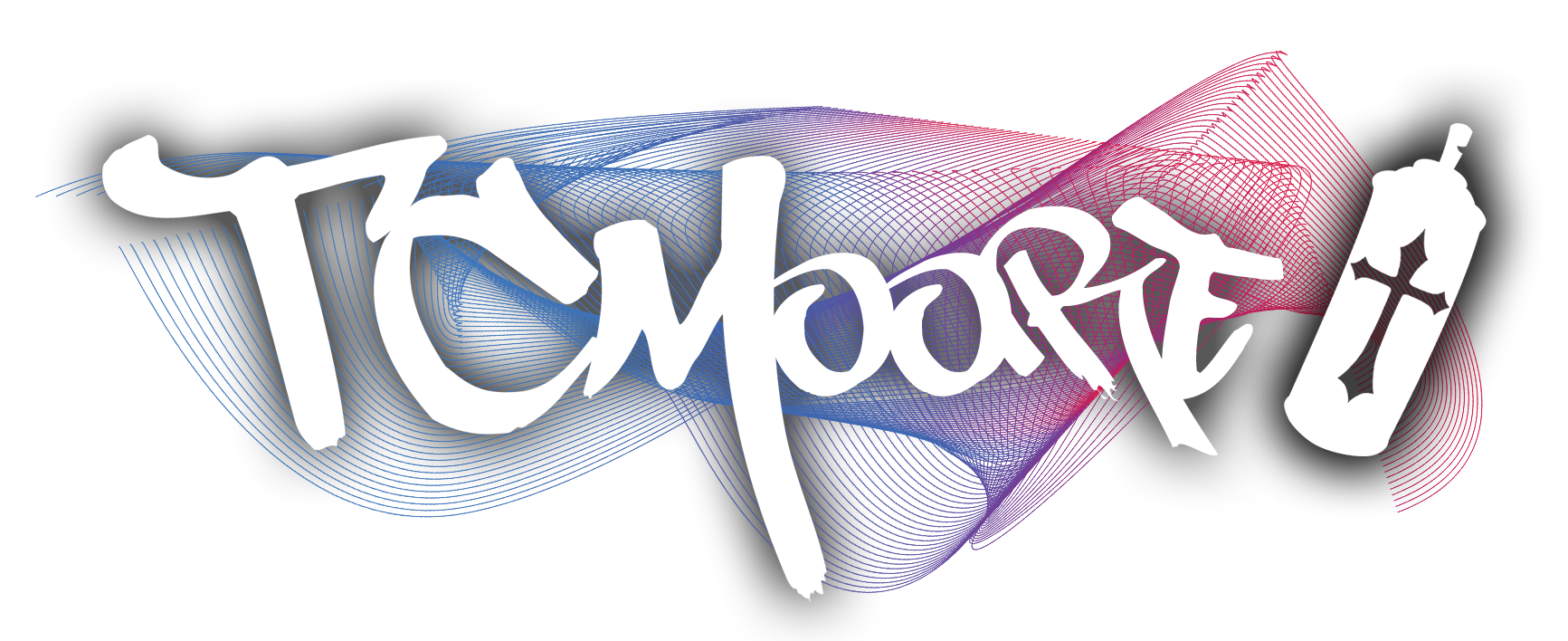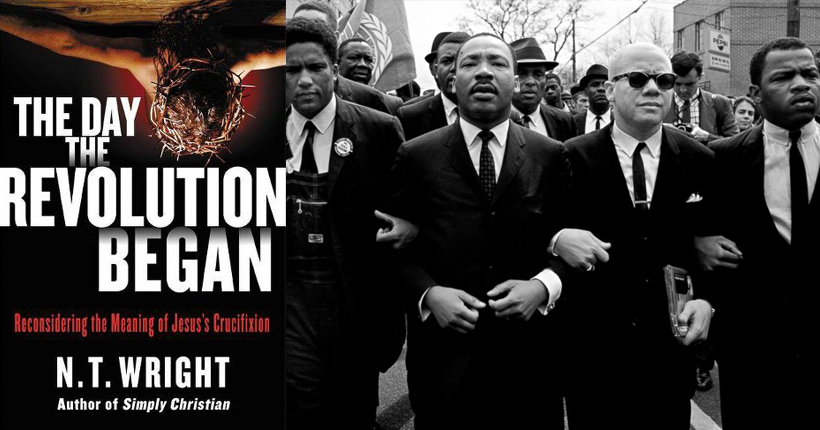Some who are attracted to N. T. Wright’s theology and affirm much of it nevertheless also deny the existence of systemic racism—something Wright acknowledges. They aren’t entirely to blame for this contradiction, since Wright has written surprisingly little on the subject. However, Wright has been explicit about his theology of the “principalities and powers” and their defeat on the cross of Jesus. This theme is actually quite central to Wright’s theology. For example, in The Day the Revolution Began he clearly connects the defeat of the powers on the cross with the overthrow of evil that is systemically present in society—systemic evil that includes racism. Therefore, it is accurate to say that N. T. Wright’s theology entails an essential acknowledgement and renunciation of systemic racism, regardless of how disappointing that may be to some of his most ardent, albeit confused, supporters.
Wright’s Theology of the Cross
In The Day the Revolution Began, Wright critiques the popular portrayal of what is often called the “Penal Substitution” theory of the atonement. It may even be fair to say he critiques the core idea of it. Here’s a brief but sufficient sampling:“You cannot rescue someone from the scars of an abusive upbringing by replaying the same narrative on a cosmic scale and mouthing the words ‘love’ as you do.” (p.44) “In most popular Christianity, ‘heaven’ (and ‘fellowship with God’ in the present) is the goal, and ‘sin’ (bad behavior, deserving punishment) is the problem. A Platonized goal and a moralizing diagnosis—and together they led, as I have been suggesting, to a paganize ‘solution’ in which an angry divinity is pacified by human sacrifice.” (p.74) “Doubtless [Paul] was aware of the non-Jewish meanings of someone ‘dying for’ someone else or for some cause, and doubtless he was aware of the dangers of saying what had to be said in such a way as to give credence to the idea of a detached, capricious, or malevolent divinity demanding blood, longing to kill someone, and happening to light upon a convenient innocent victim.” (p.232) “This is why I have said that the real danger in expounding the meaning of Jesus’s death is to collapse it into a kind of pagan scenario in which an angry God is pacified by taking out his wrath on Jesus.” (p.257)Instead of the very pagan idea of angry gods being pacified by venting their wrath upon an innocent human victim as a blood sacrifice, Wright’s theology of the cross necessarily entails Jesus’s paradigmatic conflict with the rulers and powers demonstrated throughout the story of the Gospel told by Matthew, Mark, Luke, and John, and retold by Paul and the other apostles. He writes,
“We have already heard the cryptic hint in 1 Corinthians 2:8, where the ‘rulers’ wouldn’t have executed Jesus if they had understood who he was and what the result would be. Here [in Colossians 2.13-15] the point is spelled out far more graphically. If we ask Paul what had happened when Jesus died—if we bring to him our question of what had changed by six o’clock on that evening, what was different about the world, what was now true that hadn’t been true twenty-four hours earlier—I think this is one of the primary things he would have said, that the rulers, the powers, had been defeated. When Paul speaks of the ‘rulers and authorities,’ he means both the visible rulers, the Herods, the Caesars, the governors, and the priests, and the ‘invisible’ rulers, the dark powers that stand behind them and operate through them. By the time Jesus’s body was taken down from the cross, Paul believed, these ‘rulers and authorities’ had been stripped, shamed, and defeated.” (p.258-259)For Wright there are two ‘dimensions’ so to speak of the enemies who opposed Jesus and over whom Jesus triumphed through the Cross and Resurrection. These two dimensions are the “visible” and the “invisible.” The visible enemies are the literal governors, officials, religious leaders, and military figures who oversee the social systems of the world. Examples are plentiful but three figures loom large in the narrative of the Gospel. Herod is a ruler who represents the power of wealth and corrupt economic systems. Meanwhile Caiaphas (the High Priest) represents the corrupt religious system. And, thirdly, Pontius Pilate represents the corrupt military empire of Rome. These three rulers and powers who normally were at odds with each other, conspire together against their shared enemy: Jesus. Behind these visible rulers and powers, Wright teaches us, lurk dark forces of evil that “operate through them.” Chief among these dark forces is the one called “the satan.” This week’s Gospel reading is from John chapter 12, in which Jesus says this world must have its “ruler” cast out. John is telling a story that culminates in Jesus’s showdown with the satan (ha satan), which means the accuser. We can see this, for example, in how John tells the story of Judas’s betrayal. John says the satan entered Judas:
“The satan, the accuser, has already put it into Judas’s heart to betray Jesus (13.2). Judas will be the accuser’s mouthpiece, embodying and enacting the great accusation, the anti-God, anticreation, antihuman force at large in the world.” (p.412)To sum up where we are so far: For N. T. Wright, Jesus’s Cross is an essential part of the Gospel story being told in the New Testament. However, Wright bluntly critiques popular notions of the meaning of Jesus’s Cross as “pagan”—particular portrayals that center around the idea of an angry God demanding the blood sacrifice of an innocent human victim. Instead, Wright sees in the New Testament a theology of the Cross that necessarily entails the defeat of the ‘rulers’ and ‘powers.’ These rulers and powers are both the visible governors, officials, and leaders as well as the invisible, dark powers of evil that operate through visible rulers. For Wright these dark forces are “anticreation” and “antihuman.”
The Defeat of the Power of Racism
For N. T. Wright, the evil forces that operate through visible rulers are often expressed in idolatrous ideologies and oppressive systems of power. He writes,“…when there are forces at work in our world dealing in death and destruction, propagating dangerous ideologies without regard for those in the way, or forces that squash the poor to the ground and allow a tiny number to heap up wealth and power, we know we are dealing with Pharaoh once more. Idols are being worshipped, and they are demanding human sacrifices. But we know that on the cross the ultimate Pharaoh was defeated.” (p.378)We don’t have to guess at what examples Wright might give of these oppressive forces at work in our world, because that’s the subject of the next chapter, the conclusion of the book. Here he details some historical systems of oppression the cross defeats, which point to present-day ones.
“What might it mean for the church today to live by the same belief? It would mean recognizing, for a start, that the ‘powers,’ though defeated on the cross, are still capable of enslaving millions. When we in the Western world think of forces that enslave millions we tend to think of the ideologies of the twentieth century, not least Communism, which until 1989 had half the world in its grip and still controls millions. Many in southern Africa think back to the terrible days of apartheid and remember with a shudder how racial segregation and the denial of basic freedoms to much of the nonwhite population were given an apparent Christian justification. Similar reflections continue to be appropriate in parts of the United States, where the victories won by the civil rights movement in the 1960s still sometimes appear more precarious than people had thought. […]Those of us who remember the 1970s will recall that commentators predicted, as a matter of certainty, a major civil war in South Africa. That this did not happen was largely due to that patient, prayerful struggle. Similar things might be said about the work of Martin Luther King, Jr., and many others in America, speaking with a powerful Christian voice that refused to be drowned out by the Ku Klux Klan, on the one hand , or the militant Black Power activists, on the other. These things have happened in my lifetime, and they are neither to be discounted nor explained away as the inevitable progress of enlightened liberal values in the modern world. As we should know, there is nothing inevitable about such things. What we witnessed was the power of the cross to snatch power from the enslaving idols.” (p.392-393)Let’s recap once again, just so no one misses it. For N. T. Wright, Jesus’s cross is necessarily about the defeat of the ‘rulers’ and ‘powers’ that have both ‘visible’ and ‘invisible’ dimensions. The visible dimension are the governors, the officials, and the leaders who represent social systems. The invisible dimension are the forces of evil that operate through them—forces which Wright describes as “anticreation” and “antihuman.” Oppressive systems that “squash the poor to the ground and allow a tiny number to heap up wealth and power” are demonic and defeated by Jesus’s cross. When Wright looks for historical examples of how the cross defeats these powers, he finds several that are racist social systems. He points to the apartheid system of racism in South Africa and he points to the White Supremacy system of racism in America. He credits leaders like Desmond Tutu and Martin Luther King, Jr. as prophetic Christian voices who lived out the belief that the powers are defeated by Jesus’s cross through their protests and movements for social change. The only conclusion that can be drawn from this evidence is that for N. T. Wright the meaning of Jesus’s cross directly translates into opposition to systemic racism in societies like the United States. For N. T. Wright political organizing against “antihuman” systems is an essential part of our role as Christians.
“As Christians, our role in society is not to wring our hands at the corruption of power or simply to pick a candidate that supports one or another supposedly Christian policy. The Christian role, as part of naming the name of the crucified and risen Jesus on territory presently occupied by idols, is to speak the truth to power and especially to speak up for those with no power at all. I have seen this again and again, mostly in cases that never make the newspapers but significantly transformed actual communities. I saw it when friends working in the prison system, some of them as chaplains, were able to go to the prison governors and point out ways in which the system was failing to protect many highly vulnerable young people in their care. I saw it when a small group managed to protest successfully on behalf of a man who had fled for his life from another country at a time when the government was keen to boost its statistics for keeping such people out. […]A central part of our vocation is, prayerfully and thoughtfully, to remind people with power, both official (government ministers) and unofficial (backstreet bullies), that there is a different way to be human. A true way. The Jesus way. This doesn’t mean ‘electing into office someone who shares our political agenda’; that might or might not be appropriate. It means being prepared, whoever the current officials are, to do what Jesus did with Pontius Pilate: confront them with a different vision of kingdom, truth, and power.” (p.400-401)This blunt acknowledgement of the existence and evil of systemic racism will no doubt trouble those who are attracted to Wright’s theology but deny the reality of systemic racism. Nevertheless, it is a fact that not only does Wright acknowledge this reality, his theology of systemic racism’s defeat by Jesus’s cross as an instance of demonic power is an essential aspect of this view of the Christian Gospel and the church's mission in the world.


